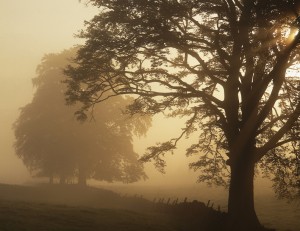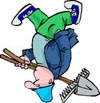For all too many years nurseries have pushed soil amendments as a tie in leader along with everything else. They were right and they were wrong! Despite evidence to the contrary only recently did extension services and nursery professional’s reverse the standard advice to put amendments into the planting well. Finally they have ‘seen the light’ and follow what orchard managers and foresters have known for years. Back fill with the existing soil. Period!
The consequences of having two drastically different soil types. (Often three)1. The clay root ball or nursery potted soil, replanted in your own amended planting hole and 2.The soil that you have naturally. 3..Every transition for the transplantee is difficult and causes the roots of transplanted trees to treat over amended soils as a barrier. 4. The addition of some soil amendments if purchased from say a compost source may include pathogens such as fungii, bacterial or virus’s. Considering the source of dead refuse ground up and improperly composted this is a major concern. You may be introducing more problems than you know.
If there ever were commandments for transplanting they might read as follows:
1.Plant most trees in a well-drained site with the root collar just below the surface.
2.Unless you are dealing with serious clay, use the soil you have and go lightly on amendments and chemical fertilizers. If dealing with clay soils read more on the subject below.
3.When planting with good topsoil do not dig deep pockets but wide ones. Every inch counts! While planting protect the roots from drying out from sun, wind or simply the trip home from the Nursery. If the Nursery doesn’t suggest or offer those means, seek another!
4.After planting tamp the soil down around the roots, your boot or a two by two will do. Never tamp down wet watered soils.
5.Build a dam around the tree and water heavily after planting.
6.Be very careful about over pruning, another Nursery myth. Top growth does not necessarily have to be whacked back to compensate for root loss. Pruning is a complicated issue and another issue entire. A small portion follows in the article.
7.Control weeds by a straw mulch or other means to prevent weed competition in a two yard circumference from the center.(The crown of the tree can be slightly below this mulch.)
Site preparation in advance allows soils and amendments to settle. Soils that are poorly drained need to be improved before planting. In these soils incorporating organic materials may be helpful. Improving drainage however is foremost. Many trees drown within a few years if planted in poorly drained soil. In our state many new houses are built on properties that actually have the topsoil removed — what remains is poor and compacted. (You then have the privilege of buying the soil back from the soil yard at 16.00 a yard.)
A fair test for soil drainage is as follows: The rule of thumb is to dig a hole about 12 inches deep, fill it with water in the evening and check in the morning. It should be empty! The idea is to have drainage of an inch an hour. Most trees require a soil depth of some two feet so if you feel ambitious test to that level. Many will survive (read I do not say do well) in soils much shallower. They will always be less stable to wind damage and to droughts. Having a stagnant smell and a yellow or blue clay color can also identify such poor draining soils.
If your soil does drain well, dig your hole and it should not be much deeper than the root ball. I do tend to put a planting fertilizer in the bottom (including bone meal or hoof and horn) then cover up with native soil — then plant the tree. The hole should be much wider than the root ball. Every inch dug increases the plants good growth and survival.<br>
I add no other amendments to the soil! Other than some inclusions of homemade compost or mycorrhrizial inoculations few amendments do much to help the tree, if anything these artificial enhancements may actually inhibit the tree roots when they hit the barrier of the planting hole. The tree will grow more slowly for the first three years as opposed to a planting well,organically amended — but AFTER three years the tree planted in unamended soil will outgrow the other.
Always rough edge or fork the sides of the planting hole to allow the roots easier penetration into surrounding soils. A clean spaded hole is not what you want! This is of special import if you are so unfortunate to be planting in clay!.
Be careful not to plant the tree too deeply – soils will settle regardless and lower the tree even more deeply into the hole. Back fill the soil tightly with your feet or a two by two to remove all air pockets that can dry out roots. (For clay soils there is a different method.) Tamp and compress – but do not crush the roots. Build a dam or moat around the tree and flood the basin with water; this will settle the soil somewhat more. Add some compost or soil to compensate for settling — never, further stamp or compress the soil after it is wet. In well-drained or sandy soils slope the planting well towards the tree, conversely on wet clay soils build a moat close to the tree and slope the soil away from the tree.
There is much more to planting a tree, but I am only going to concentrate on the issue of soil amendments.
Clay soils.
1. Look elsewhere for an alternative site
2. Choose a tree that tolerates wet claylike soils, such as Pin Oak, Ash, Hawthorn, Metasequoia, Salix, Taxodium or some Maples.
3. Amend a VERY large area by working in organic material such as compost or wood fines (not manures of peat moss). Coarse sand and Perlite are also very helpful.** 4. Bring in some good topsoil and replace the clay soil and make a raised planting mound. Never work clay soils while wet!
5. If possible install a serious perforated drainage system to drain this problem area. Be careful that the outflow does not impact a neighbor.
6. If the clay is a layer issue, with better draining strata beneath, rent a soil auger and drill through the clay, replace the augured soil with topsoil or coarse sand or even insert vertical perforated pipe into the four foot hole and back fill with gravel. Your planting instructions would be as #4.
**Sand and Perlite do not improve drainage; they do however improve soil structure and tilth! Soil basically is a crumb cake with everything the home gardener decides to add to the recipe. Improving the network of pores in a soil will allow water, nutrients and AIR to better circulate.
Coarse sand does help, as clay particles are the finest of all soil particles, and because they are so small they offer the greatest surface area per volume of soil. Space between them is also very small — another issue entire. Namely reducing space for air. Clay becomes sour partly because there is little aeration. Coarse sand if incorporated will take up that percentage of the soil, and less water can adhere to that volume of sand particles than the same of clay.
Sand and perlite are near permanent additives to the soil, so is pumice. Vermiculite lasts only a few years. ALL other organic materials added would in time decompose reducing by volume by up to 80% (manures especially), the base soil will return much to what it was like originally. It may take 8 years but it will. Sand and Perlite amended soils will not. I am presently pulling out dying plants planted in an alder chip amended soil mix that has all but disappeared.
That is not to say they should not be added! Plants will initially grow much better with any generous addition of organic material. That is a matter not only of improved tilth, but also of making soil microorganisms (bacteria, fungi) a bit more welcome. All these need AIR, water and nitrogen to survive and prosper. Clay soils are virtual deserts to these organisms — one must add WARMTH. Clay soils are cold soils.
Soils enriched with organics warm up earlier in spring. (Fine sands may actually make things worse; manures can give off toxic ammonia gases and other substances that may be toxic.) Use manures in late spring as a top dressing, but never as an additive. On mature trees apply to soils in the fall and leave uncultivated over winter. All straws, barks, organic materials use up nitrogen as they decompose so be sure to incorporate some form of nitrogen.
The combination of COARSE Sand/, Perlite, /Pumice, and organics with the clay in raised beds is the best possible method of improving the soil. Drainage systems excluded!
**2 Curtain drains, auger bores to penetrate the clay barrier also help. It means you have to divert water away, or through the clay barrier. A wonderful tool if you are lucky to have something soils more permeable beneath. This is a method not often enough used. In my area we have soils that may be 2-3 feet of yellow or blue clay, overlaying a rocky sandy mix below. Renting a four-foot auger I proceeded to dig four ft. deep holes through the lawn area to be. This is after criss-cross trenching the site first. The augured holes go in where the lines cross. In these I put a wrapped 6″ perforated drainage pipe — filled with rock. All drainage pipes came to these. The soil drained better and wasn’t diverted to a neighbor.
After all of this, YEARLY additions of compost, salt free manures are very, very important. Even if the organics in the base amendment slowly deteriorate in volume, earthworms can bring some movement of topdressings down to the layers beneath, by leaching. Most however, will and forever remain on the top.
One last note if you add a lot of fir bark or wood products, be sure to add some nitrogen as well. Ammonium sulfate or manure are two easy options. Sulfates may make your soil acidic, so consider adding some lime as well. Manures can add salt to the soil as well.
Top pruning to compensate for root loss is another nursery myth. Good pruning to create an attractive branch structure is all right. I try not to remove too much, and those limbs I do cut off I leave a stub, to trick the tree into thinking it still has a limb there. Those buds will also leaf out next spring and give some shade to the trunk of the tree.
balled-and-bur lapped trees! Another topic altogether!
A final note, if buying store bought compost or planting soils always were gloves when handling them. You really never know what is in them or how well composted they are. If they include Vermiculite make sure the compost is moistened so you do not inhale the material. Old bags of compost can also harbor many lung infecting fungus’s so if you come down with something don’t be surprised. BTW, Costco for years sold a very good (growing wise) planting mix that included bat guano. There could be problems with that and as I noted it was soon removed. Same issue with organic blood meal, hoof and horn and bone meal.
© Herbert Senft 2010




http://portocallpublishing.com/2014/10/19/a-sierra-club-presentation/
SAVOR YOU SOIL: Know Your Compost! A presentation by the Sierra Club about soil and compost. This received the following comment: “This is likely a session to bash the city’s biosolids compost even though it is the only locally produced compost to undergo any laboratory analyses.The ONLY way to really know what’s in a batch of compost is to use your own feedstock and make it yourself.”
I replied:
“The ONLY way to really know what’s in a batch of compost is to use your own feedstock and make it yourself.” You are correct on that.. As for the introduction you presume much. The difference between city manufactured compost and your own basically comes down to what is put into it.
1. Even home made compost using say three bins and thermometers is a damn hard task. And with our cool weather the task of bringing a bin up to and keeping a sterilizing temperature is hard to do.. The corners and bottom always remain in question – hence the rotations..
2. Generally speaking even the dumbest gardener does not compost diseased material but burns or disposes of it. City compost (and soil yards) do not!
3. The materials you put into your compost pile have a major impact on how well the composting process works and the quality of the final compost. This involves the percentage of carbon material and nitrogen to make it work. C:N. ratio. The gardener can monitor that, and although everything will eventually decompose or rot … that does not equal composting.
4. Bio-solids like sludge or pet wastes, cat litter require special handling and much higher temperatures that cannot be obtained by simply turning the material over.
5. Incorporating diseased plant material in your compost is what these city dumps and soil yards do and having been in the business for over 30 years, you’ll probably end up with more problems than you started with.
Much better to buy raw bark and manure and start with that. IMO the only facility that treated yard wastes well was Pt. Townsend.
I had planned to attend but came down with a cold, so did the presenter. She decided to do the presentation anyway and I suggest that you not make presumptions until you have heard what she had to say…
Another very informative article. I am so thankful to have found you. I have a few questions fo clarification.
You mentioned preparing soils in advance of transplanting. How far in advance are you speaking of?
What if you have such good drainage, due to being on an old riverbed, with soil that is mainly sand and river stones? I have been slowly improving the topsoil mainly by digging holes for plants, and adding manure. This has really only affected the top 3 inches I would say. We used an excavator to dig down 6-12 inches depending on the compaction (the excavator seemed to be in jeopardy of tipping over in some areas). The neighbor said in some areas I’m working over 6 feet of rock from the old road. UG.
Anyway I had planned to mix in more Aged manure/hay mixture and some form of wood chips before planting what are currently very small shrubs and trees, but shall hopefully become great
So many questions.
1. Preparation for plantings should best be done in the fall before.
2. As for making topsoil, you are talking about your grand kids if even then. Cheating by buying in composts, barks and manures will usually decompose down to say 1 inch after a two or three years. For that reason amending your soil for a tree planing is not that great an idea as eventually all that planting mix will break down and actually become a drainage problem. One, for the sump you have created and secondly for the smaller particles it evolves into. Manures, local peats (mucks) are especially bad for this. For rocky soils that does not matter much, but if you have a clay soil that does not drain you may actually compound your problems. Coarse perlite and or Fir bark chips would be better for this.
3. All that said, you still have plenty of sand and soil in among your rocks and you may be surprised at how well the plants will grow. Don’t forget you are also blessed with superb drainage, vs. those who are afflicted with blue or yellow anorexic clay soils.
IMO, top dressing yearly with homemade compost or hay/manure mixes would be the best thing you could do. Your issue will be watering and any good top dressing will help. Mind you, you might end up with vole or mice issues so keep an eye on that. They can easily girdle a tree over a snowy winter and you won’t be aware of the problem until it is too late.
I would really concentrate on applying N. fixing cover crops that will carpet your trees and if you have heavier soils some of these choices may actually help improve the drainage as the penetrating roots alive or even when decayed will allow water and air to move into the soil.
Winter rye, buckwheat, red, or crimson clover, vetch, perennial peas, soybeans are all things to consider. Sainfoin is a new plant to try on.